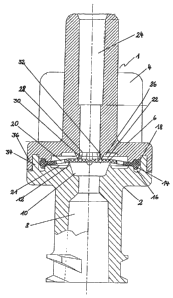Some of the information on this Web page has been provided by external sources. The Government of Canada is not responsible for the accuracy, reliability or currency of the information supplied by external sources. Users wishing to rely upon this information should consult directly with the source of the information. Content provided by external sources is not subject to official languages, privacy and accessibility requirements.
Any discrepancies in the text and image of the Claims and Abstract are due to differing posting times. Text of the Claims and Abstract are posted:
| (12) Patent: | (11) CA 2606540 |
|---|---|
| (54) English Title: | CHECK VALVE, ESPECIALLY FOR MEDICAL USE |
| (54) French Title: | CLAPET ANTIRETOUR, NOTAMMENT A USAGE MEDICAL |
| Status: | Granted |
| (51) International Patent Classification (IPC): |
|
|---|---|
| (72) Inventors : |
|
| (73) Owners : |
|
| (71) Applicants : |
|
| (74) Agent: | CASSAN MACLEAN IP AGENCY INC. |
| (74) Associate agent: | |
| (45) Issued: | 2010-11-09 |
| (86) PCT Filing Date: | 2005-06-15 |
| (87) Open to Public Inspection: | 2005-12-29 |
| Examination requested: | 2007-10-30 |
| Availability of licence: | N/A |
| (25) Language of filing: | English |
| Patent Cooperation Treaty (PCT): | Yes |
|---|---|
| (86) PCT Filing Number: | PCT/EP2005/006425 |
| (87) International Publication Number: | WO2005/123176 |
| (85) National Entry: | 2007-10-30 |
| (30) Application Priority Data: | ||||||
|---|---|---|---|---|---|---|
|
The invention relates to a non-return valve, particularly for medial
applications, comprising a first tube connection housing (2), a second tube
connection housing (4) and a diaphragm disk (6), which is made of flexible
material, is placed between both tube connection housings, and which, in the
existence of an excess pressure inside an entry passage in the first tube
connection housing, can be lifted off from a valve seat (12) annularly
surrounding an inlet space connected to the entry passage (8). In the
existence of an excess pressure inside an outlet passage (24), the diaphragm
disk can be securely pressed against the valve seat in the shortest of times,
and is provided with an annular bead (14) on its outer peripheral area. This
annular bead is accommodated inside opposing annular grooves of the hose
connection housing. The diaphragm disk is provided with openings (20) radially
outside the valve seat that are connected to an outlet space. A formation
(28), which lies on the side of the diaphragm disk (6) facing the outlet space
(22) and which holds or prestresses the diaphragm disk (6) in the direction of
the inlet space (10), is provided on the wall (26) of the second tube
connection housing (4) located opposite the diaphragm disk (6). Said formation
(28) is placed inside the boundary given by the valve seat (12).
L'invention concerne un clapet antiretour, notamment à usage médical, comprenant un premier boîtier de raccordement de flexible et un second boîtier de raccordement de flexible, ainsi qu'un disque membranaire disposé entre les deux boîtiers de raccordement de flexible et consistant en un matériau flexible, qui peut être soulevé, en cas de surpression dans un passage d'accès, dans le premier boîtier de raccordement de flexible, par un siège de soupape annulaire, entourant l'espace d'entrée relié au passage d'accès et qui, en cas de surpression dans un passage de sortie, peut être comprimé de manière fiable et dans des temps minimaux, sur le siège de soupape. Le disque membranaire comporte au niveau de sa zone périphérique extérieure, un bourrelet annulaire qui est logé dans des rainures annulaires opposées des boîtiers de raccordement de flexible. Le disque membranaire est muni d'ouvertures, dans le sens radial en dehors du siège de soupape, lesdites ouvertures étant reliées à un espace de sortie. Sur la paroi (26) opposée au disque membranaire (6), du second boîtier de raccordement de flexible (4), il est prévu une formation (28) située sur la face du disque membranaire (6) tournée vers l'espace de sortie (22). Ladite formation maintient ou contraint le disque membranaire (6) en direction de l'espace d'entrée (10). Ladite formation (28) est disposée à l'intérieur de la limite définie par le siège de soupape (12).
Note: Claims are shown in the official language in which they were submitted.
Note: Descriptions are shown in the official language in which they were submitted.

For a clearer understanding of the status of the application/patent presented on this page, the site Disclaimer , as well as the definitions for Patent , Administrative Status , Maintenance Fee and Payment History should be consulted.
| Title | Date |
|---|---|
| Forecasted Issue Date | 2010-11-09 |
| (86) PCT Filing Date | 2005-06-15 |
| (87) PCT Publication Date | 2005-12-29 |
| (85) National Entry | 2007-10-30 |
| Examination Requested | 2007-10-30 |
| (45) Issued | 2010-11-09 |
There is no abandonment history.
Last Payment of $473.65 was received on 2023-06-09
Upcoming maintenance fee amounts
| Description | Date | Amount |
|---|---|---|
| Next Payment if small entity fee | 2024-06-17 | $253.00 |
| Next Payment if standard fee | 2024-06-17 | $624.00 |
Note : If the full payment has not been received on or before the date indicated, a further fee may be required which may be one of the following
Patent fees are adjusted on the 1st of January every year. The amounts above are the current amounts if received by December 31 of the current year.
Please refer to the CIPO
Patent Fees
web page to see all current fee amounts.
Note: Records showing the ownership history in alphabetical order.
| Current Owners on Record |
|---|
| ILLINOIS TOOL WORKS INC. |
| Past Owners on Record |
|---|
| FILTERTEK B.V. |
| HOGAN, BRENDAN |
| MIJERS, JAN WILLEM MARINUS |